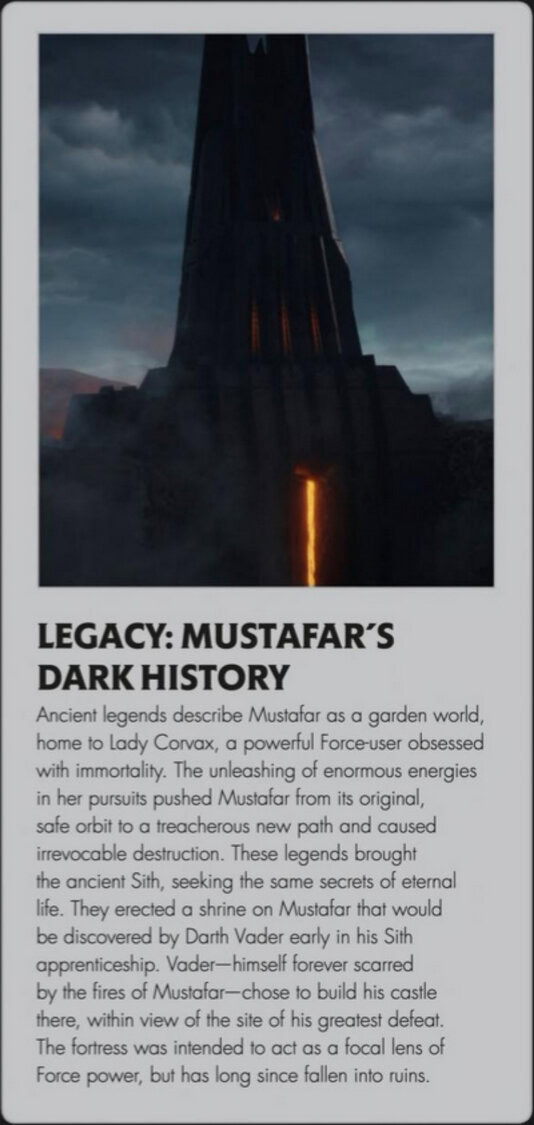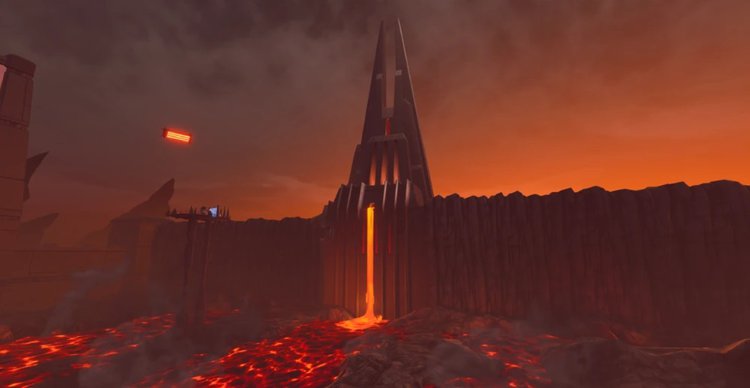When Darth Vader chose to build his home on Mustafar — the same world where he was burned, broken, and left to die — and it wasn’t a coincidence at all. Canon sources like Star Wars: The Rise of Skywalker – The Visual Dictionary (2019) and the Darth Vader (2017) comics reveal that his fortress was much more than a fortress; it reflects everything that made him who he became.
A Place of Punishment and Rebirth
Vader’s choice to live where Anakin Skywalker “died” was a form of self-punishment. He was forced to relive the worst moment of his life every day — a twisted reminder of his fall and everything he lost. But that same agony defined his rebirth. Mustafar became the crucible where Anakin burned away, and Vader emerged.
The Rise of Skywalker Visual Dictionary describes Mustafar as the site of Vader’s “greatest defeat,” where he later built his fortress “within view of the site of his greatest defeat.” This was deliberate. He turned the battlefield that destroyed him into a monument of who he had become.
To Vader, pain wasn’t something to escape — it was proof of his transformation. Every breath through his mechanical lungs, every step on the blackened soil of Mustafar, kept him tied to that moment. He didn’t heal from it; he lived in it.
Power Through Pain and Hate
For the Sith, emotion is strength. Pain, anger, and hatred are fuel. Living on Mustafar gave Vader a constant source of that fuel. The planet’s violent nature — rivers of lava, endless ash, constant storms — mirrored his inner turmoil. It kept him sharp, enraged, and deeply connected to the Dark Side.
Canon supports this idea directly. The Darth Vader (2017) comic series by Charles Soule shows that Mustafar contained a dark side locus, a place saturated with raw Dark Side energy. By building his home there, Vader anchored himself in a wellspring of power.
This wasn’t comfort; it was survival. His connection to the Dark Side required suffering, and Mustafar offered that endlessly. It was as if the planet itself screamed the same agony that lived inside him.
As Luke Skywalker later explains in The Rise of Skywalker Visual Dictionary, the castle was “constructed on top of a Sith cave on Mustafar—the lava-drenched world where Obi-Wan defeated his former apprentice and left him to die… specifically attuned to the dark energies of that world for one purpose: to pierce the veil between life and death.” That purpose would become the next step in Vader’s obsession.
Reaching Beyond Death
The heart of Fortress Vader’s story lies in its design — and in who designed it. The Darth Vader (2017) comics reveal that the fortress was the creation of the ancient Sith Lord Darth Momin, whose consciousness lived on through his cursed mask. Emperor Palpatine gave the mask to Vader, and when Momin possessed an Imperial officer, he promised to help Vader achieve the impossible: reconnect with Padmé Amidala through the Force.
Momin’s designs turned the fortress into more than architecture — it became a tuning fork for the Force. As Momin explained, the structure could channel the energies from the Sith cave below, opening a “door” to the Dark Side itself.
After nine attempts, the final version of the castle succeeded. Vader briefly opened the portal and entered the Dark Side realm in search of Padmé. He saw visions of his past, but he failed to bring her back. The experience only deepened his despair. In rage, he destroyed the portal — yet he kept the fortress as his home, turning it into both sanctuary and prison.
Through this act, Mustafar became more than his punishment or his power source — it became his temple, where he tried to undo death itself.
The Dark Nexus of Mustafar
Mustafar’s tragic history predates Vader. According to The Rise of Skywalker Visual Dictionary, it was once a lush garden world ruled by Lady Corvax, a powerful Force user who sought immortality. Her experiments shattered the planet, tearing it from its original orbit and turning it into a volcanic wasteland. The ancient Sith later came to study the dark energies released by her actions, building temples to probe the secrets of eternal life.
Those same legends drew Vader to the planet. Beneath his fortress lay an ancient Sith shrine, a dark-side focal point connected to those old rituals. The energy that once destroyed Mustafar now flowed through his fortress, amplifying his power and echoing his obsession with mastering death.

Fun Fact: The Castle’s True Shape
Concept artist Doug Chiang confirmed that Fortress Vader’s design in Rogue One: A Star Wars Story was inspired by unused Ralph McQuarrie sketches from The Empire Strikes Back. The final structure resembles a tuning fork, reflecting its purpose to channel and “tune” the Force’s dark energy.
In-universe, this matches Momin’s idea from the comics — the fortress’s twin towers literally focus dark energy upward, like a frequency resonating through the Force.

